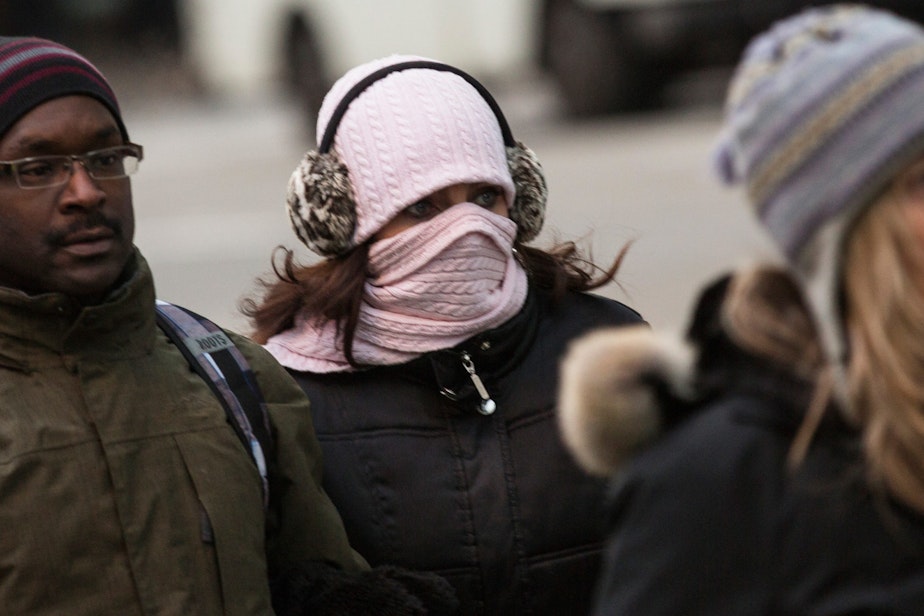What Is The Dreaded Polar Vortex, And When Could It Arrive?

Fluctuations in the band of frigid Arctic air known as the polar vortex could bring severe winter weather to much of the United States in the coming weeks.
Here & Now‘s Jeremy Hobson talks with Judah Cohen, director of seasonal forecasting at Atmospheric and Environmental Research and visiting scientist at MIT’s Parsons Lab, for more of an understanding of what the polar vortex is and how it impacts winter weather.
What Is The Polar Vortex, Exactly?
“The polar vortex is an area of low pressure that sits right over the North Pole high up in the atmosphere, about 20-30 miles above the surface,” Cohen says. “Around the polar vortex is a fast-flow ribbon of air that kind of keeps the cold air confined inside of the polar vortex, and then you have milder air that flows on kind of the periphery, or outside of this vortex in the mid latitudes, say where we are, most of the industrialized nations here in the mid latitudes.
“I’ve been part of research that’s shown that we’re getting more of … this meandering polar vortex, this wandering polar vortex, we’re getting more of these type of events. So instead of sitting right on top of the North Pole where it normally is, it’s been kind of heading further south more often. Typically, it likes to go towards Eurasia, if it goes anywhere. But if it breaks into pieces, like it did last year, and it’s predicted to do again this year, then one piece tends to go to Eurasia and the second piece comes to North America.”
Sponsored
How Does It Impact Our Weather Patterns?
“There are different flavors of these polar vortex disruptions. But typically, after a polar vortex event, we get an increase in the probability or frequency of severe winter weather, including cold-air outbreaks, snowstorms,” Cohen says. “And this is across the whole Northern Hemisphere. … Its favored locations are the eastern United States, Europe and East Asia, and it seems to me, an observation of mine [is], that especially where you get these polar vortex splits when they split into these daughter vortices, that increases the probability of kind of these blockbuster nor’easter snowstorms. A great example was last February, where we had this polar vortex split and we got those four nor’easters in a row along the East Coast … in early March.”
What Could Be In Store This Winter?
“When we get these big disruptions in the polar vortex like what’s predicted — and the models have been all over the place, I think there’s a lot of uncertainty surrounding this event — but the large events like the models are mostly converging [on] now, it tends to kind of slant or skew the weather to cold and snowy for up to two months,” Cohen says. “So it could take us all the way to the end of February.
“Right now, there’s no reason to expect severe winter weather, cold and snow. But from mid- to late January to maybe the end of February, I would expect a more active winter period across at least the eastern half of the United States: more cold-air outbreaks, more possibility of snowstorms. And then also, with these polar vortex splits, the western United States tends to — not necessarily, but tends to — I would say get a little warmer and drier.”
Sponsored
Is Climate Change Driving Polar Vortex Disruptions?
“That’s an active area of debate,” Cohen says. “The science is not settled, and we have different ideas, but I think the lack of sea ice, the melting sea ice, has been contributing to more of these disruptions — we call them disruptions, or perturbations — in the polar vortex. My research really started with something a little more esoteric, but Siberian snow cover, and it’s been actually been increasing in the past two decades, which is kind of a surprise result. It’s been going against the trend for all the rest of the snow and sea ice across the globe.
“[The polar vortex breaking up] is … nothing new — this I’m sure has been happening for millions of years, if not hundreds of millions of years. But it just seems to have gotten more frequent recently.”
Chris Bentley produced and edited this interview for broadcast. Jack Mitchell adapted it for the web.
[Copyright 2019 NPR]
